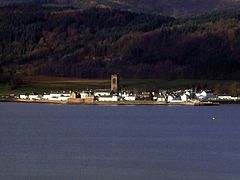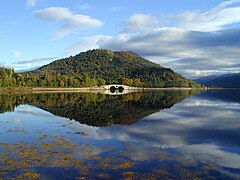inscribed "Inveraray" a page from an album inscribed in the frontispage "F W Staines 3 Uplands St Leonards on Sea"
Amelia Jackson, Nee Staines (1842 – 1925) and thence by descent
A mercat cross is the Scots name for the market cross found frequently in Scottish cities, towns and villages where historically the right to hold a regular market or fair was granted by the monarch, a bishop or a baron. It therefore served a secular purpose as a symbol of authority, and was an indication of a burgh's relative prosperity. Historically, the term dates from the period before 1707, when the Kingdom of Scotland was an independent state, but it has been applied loosely to later structures built in the traditional architectural style of crosses or structures fulfilling the function of marking a settlement's focal point. Historical documents often refer simply to "the cross" of whichever town or village is mentioned. Today, there are around 126 known examples of extant crosses in Scotland, though the number rises if later imitations are added.
A beautifully decorated ecclesiastical cross, it is rumoured to have belonged originally in a graveyard before the 3rd Earl of Argyll moved the whole town of Inveraray to New Inveraray, where it has been positioned in front of the harbour since 1839.
The memorial cross features an inscription down one side, and translated from Latin reads as:
“This is the cross of noble men, namely Duncanus MacCowan, Patricius, his son, and Mael-Moire, son of Patricius, who caused this cross to be made.”
I’ve included an image from a 19th century book titled The Sculptured Stones of Scotland, vol II, which shows in amazing detail the crosses intricate woven celtic vine design & carved animals.
👑 Although not originally intended as a mercat cross, there is evidence of it being used as one before it was moved. Positioned on a 3 stepped stone base, it is a beautifully carved cross, retaining an incredible portion of its original design. The front facing portion of the cross is well worn and it was hard to identify any of the small carved animals that appear in the second image below.
You’ll find this A-listed mercat cross down by the harbour, right on the corner of Main Street East/ West & Front Street, right in the heart of the conservation area of Inveraray.
Take some loose change when visiting this one – it looks as though this cross is a lucky charm for the village!
Take a look at canmore, Argyll & Bute site, & thehazeltree.co.uk for more information on this mercat cross.
Inveraray is a town in Argyll and Bute, Scotland. It is on the western shore of Loch Fyne, near its head, and on the A83 road. It is a former royal burgh, the traditional county town of Argyll, and ancestral seat to the Duke of Argyll.
During the Second World War the Combined Operations Training Centre, located close to the town, was an important military facility.
The town's coat of arms depicts a net cast out over the ocean, entangled in which are five herrings and the Latin motto "SEMPER TIBI PENDEAT HALEC" (possible English translation: "may a herring always hang to thee").
Arthur Charles Fox-Davies, in his 1909 book A Complete Guide to Heraldry, notes the following:
There is no doubt of its ancient usage. ...and the blazon of the coat, according to the form it is depicted upon the Corporate seal, would be for the field: "The sea proper, therein a net suspended from the dexter chief and the sinister fess points to the base; and entangled in its meshes five herrings," which is about the most remarkable coat of arms I have ever come across.
Main article: Inveraray Castle

In 1744 the third Duke of Argyll decided to demolish the existing castle and start from scratch with a new building. The castle was 40 years in construction, and the work was largely supervised by the Adam family, still renowned to this day as gifted architects and designers. The end product was not a castle in the traditional sense, but a classic Georgian mansion house on a grand scale, Inveraray Castle.
Over the years the castle has played host to numerous luminaries; Queen Victoria visited it in 1874, and the Royal connection was further cemented when her daughter, Princess Louise, married the heir to the Campbell chieftainship, the Marquess of Lorne, in 1871, illustrating the elevated position of the Argyll family in the social order of the times.

In 1747, William Adam had drawn up plans for the creation of a new Inveraray. By 1770, little had been done, and the fifth Duke set about rebuilding the town in its present form. Some of the work on the rebuilt Inveraray was done by John Adam. The Inveraray Inn (formerly known as the New Inn, Great Inn, Argyll Arms Hotel and Argyll Hotel) on Front Street being his, as well as the Town House. Much of the rest of the town, including the church, was designed and built by the celebrated Edinburgh-born architect Robert Mylne (1733-1811) between 1772 and 1800.
The end product was an attractive town which included houses for estate workers, a woollen mill, and a pier to exploit herring fishing, which was to grow in later years to play a major role in the town's economy. The finished product is one of the best examples of an 18th-century new town in Scotland, and the vast majority of the properties in the centre of Inveraray are considered worthy of protection because of the town's architectural significance.
In addition to the castle, the Georgian Inveraray Jail in the burgh is now a museum. Other attractions include the Argyll Folk Museum at Auchindrain. The Celtic Inveraray Cross can also been seen in the town. The Clyde puffers VIC 72, Vital Spark. The Bell Tower dominates the town, and contains the second-heaviest ring of ten bells in the world. The bell tower is open to the public, and the bells are rung regularly.
In autumn 2014, PBS premiered a series, Great Estates of Scotland. Inveraray was featured in one episode, as was the present Duke of Argyll, head of the Campbell clan.
-
Inveraray, viewed from the B839 on the Eastern side of Loch Fyne, above St Catherines
-
Aray Bridge on Loch Fyne from Inveraray. The spires of Inveraray Castle can just be seen on the left. The hill behind the bridge is Dun Corr Bhile
-
Inveraray reflections
-
Main street of Inveraray
-
Archway from Inveraray town
-
Aray Bridge
Francis William Staines was the last of a family of merchants from the City of London. Not only was he a successful businessman but he possessed a large independent fortune, such that he could devote his time to the cultivation of his talents in music and art. He was a brilliant amateur violinist, and also loved to spend much of his time painting. His daughter Amelia and her mother accompanied Mr Staines as he travelled throughout the country finding subjects for his painting. One area of the country that they visited frequently was Scotland and the Lake District, and Amelia grew particularly fond of the dramatic landscape of the Fells. Skelwith Bridge with the view of the hills around it 43 was one of her father’s favourite scenes. He painted landscapes and maritime paintings , exhibited 11 works at the RA including views on the Italian Coast, address in London, Hastings and St Leonards on Sea Susssex.








